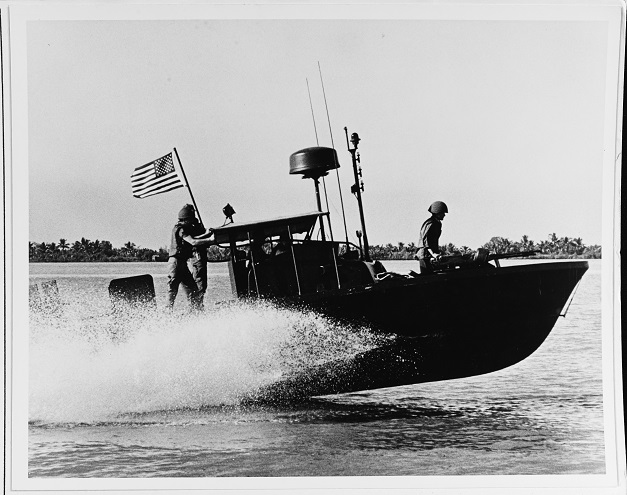
The Navy Laboratory Analysis Augmentation Group–Vietnam was established in 1960s to provide analytics to Commander, Naval Forces Vietnam, VADM Elmo R. Zumwalt, Jr.. A number of such programs existed during Vietnam, including the Vietnam Laboratory Assistance Program and the later Navy Science Assistance Program, for Navy laboratories to provide immediate R&D support to the forces on the ground. For more reading on these programs, check out The Sound of Freedom. A number of scientists from Dahlgren participated in these programs, including Donald George, Fred Willis, and Wayne Harman.
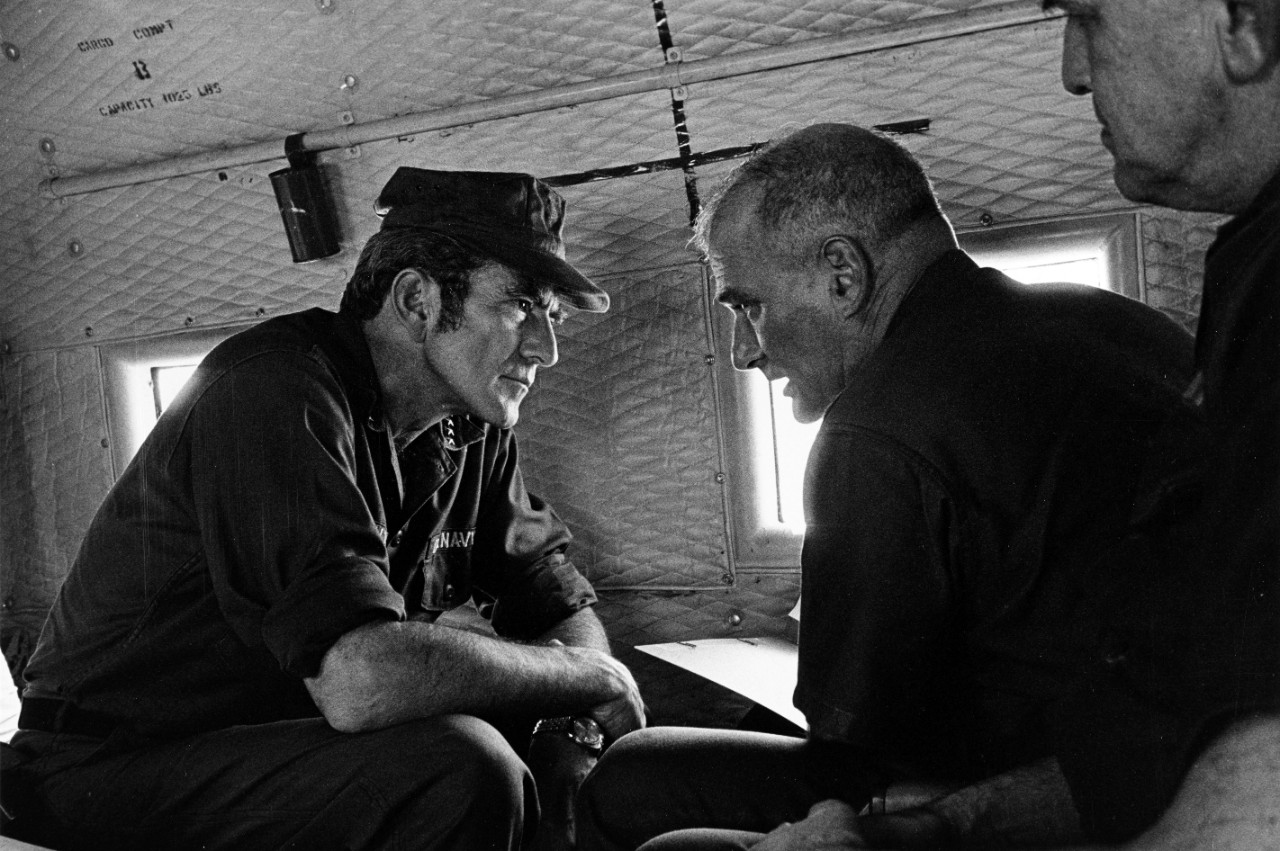
ADM Elmo R. Zumwalt. Jr., USN, Chief of Naval Operations (left), and Commander Naval Forces Vietnam Discuss their recent visit to Nam Can Naval Base, Republic of Vietnam, as the fly to their next stop, May 1971. Official U.S. Navy Photograph.
Wayne was 28 years old, working in the Guidance and Reentry Analysis Branch on reentry vehicle trajectory studies for Polaris. He arrived in Vietnam in June 1969 and stayed for four months. During that time, he primarily supported Operation Sealords. He wrote the following information for us on his experiences as part of NLAAG-V.
My Time in Vietnam
By Wayne Harman
I was at the Naval Weapons Laboratory in 1968 and noticed an announcement about a speaker coming to the base to talk about his group in Vietnam.
They were looking for volunteers to come over to support VADM Elmo Zumwalt, as he commanded the naval forces fighting in Vietnam. This group was called Navy Laboratory Analysis Augmentation Group–Vietnam (NLAAG-V). This was a group from the Navy laboratories that took questions from VADM Zumwalt, researched them, and provided him with information on the particular subjects.
I thought this an interesting way to find out what was going on in Vietnam at the time so I volunteered. I had been at the NWL for about two years and was working in the Fleet Ballistic Missile program in K Lab on Reentry analysis.
I was still rather young and was not married so I was not inhibited by family matters (no wife, no kids). Soon I was on my way.
A small group of us, six from the navy laboratories, gathered at a training base in California, the Navy Amphibious Base at Coronado, for two weeks of orientation about Vietnam, the weapons we would have to carry, the food, the language, etc.
Very soon we were on our way to Saigon, the capital of South Vietnam. VADM Zumwalt’s headquarters were there so we all were given hotel rooms near the compound. We could walk to work. The schedule was twelve hours a day, seven days a week.
First thing every morning was the daily briefing VADM Zumwalt got from his staff people. This covered operations from the day before and particular items covering what the Navy special force units had been doing. He asked questions and occasionally gave the special force guys some order about what to look for.
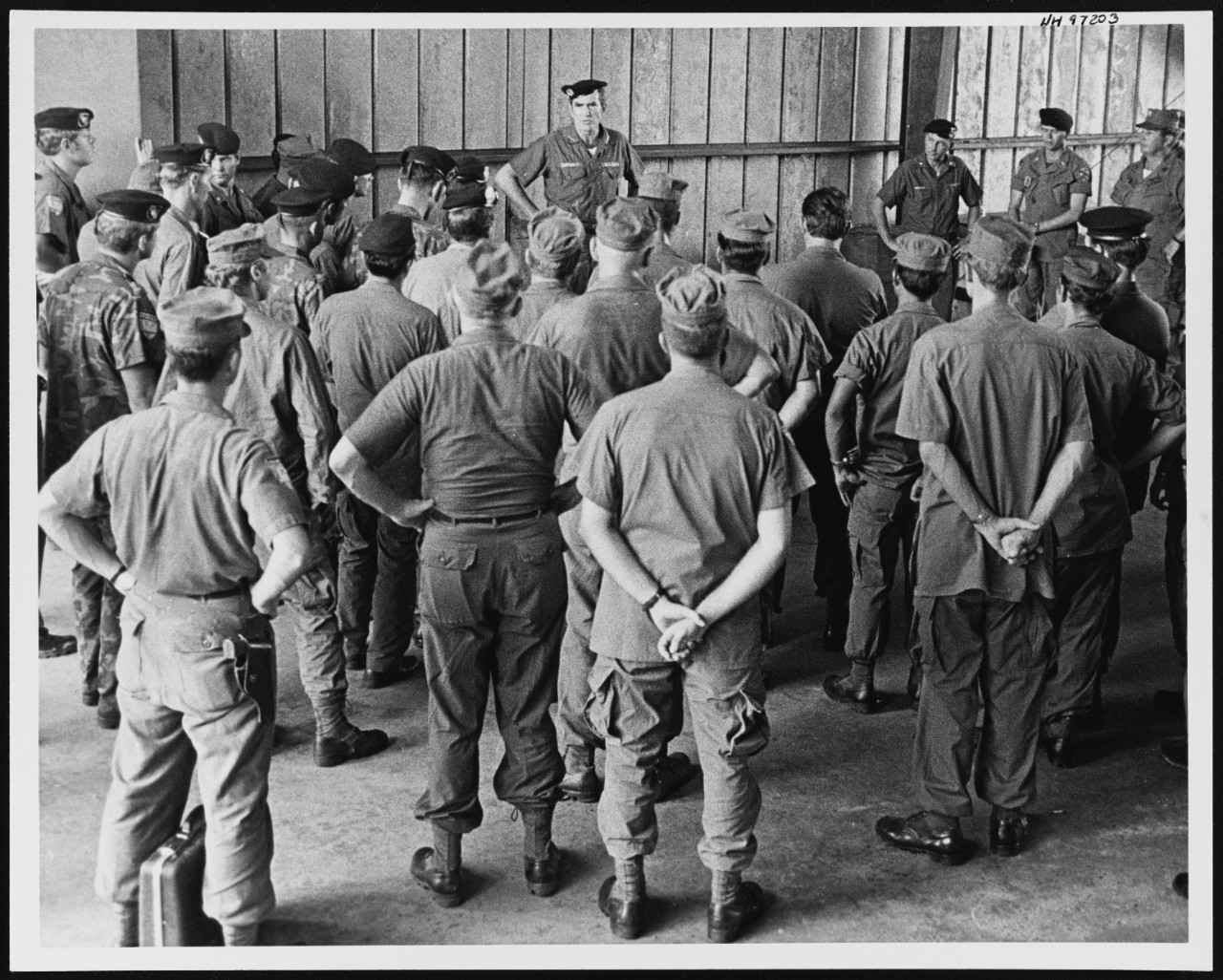
Chief of Naval Operations (center background) participates in a question and answer session with U.S. Navy Advisors at the Rach Soi Naval Base, Republic of Vietnam, in May 1971. Note berets worn by ADM Zumwalt and many of the others present. Official U.S. Navy Photograph, from the collections of the Naval History and Heritage Command.
The group was led by a Navy commander who would talk to us about what his group was trying to contribute to the war effort. He would also pick a group to go out into the field—to visit a River Division on one of the Rivers, the Vam Co Tay (West) River, the Vam Co Dong (East) River, or even the Mekong River. These were River Division bases for PBRs or Patrol Boats-Riverine, fiberglass boats about 30' long that were fast and could move quickly on the river. The fiberglass was convenient because when a rocket-propelled grenade hit, they frequently went straight through the boat without detonating. But the radar antennae high up above the boat—when these were hit, the detonation flashed fragments down onto the main deck and caused casualties. Many of the boat captains removed these antennas before they went on patrol on the river. This was frowned on by the commanders, but [I] never heard of any action taken against the boat captains who removed them.

A U.S. Navy River Patrol Boat (PBR) of river patrol force 116 moves at high speed down the Saigon River, Republic of Vietnam, November 1967. Photo courtesy of National Archives.
One of the main duties of the group was to keep casualty figures for the River Divisions. VADM Zumwalt liked to keep any one River Division from getting too many casualties, so he moved them around to less dangerous spots when they had taken too many deadly hits.
Another duty of the group was to work up interdiction methods for stopping Viet Cong traffic from the North into the South. This included where to station boats along the river, where to look for traffic along the trails from the north, and information based on other intelligence gathered by the forces.
We were never sent out into the field alone on our first visit. Instead, we were taken by a member of the group who had been in the field before and knew his way around. We usually rode helicopters going to a River Division.
At the River Division I usually looked up the commander. He assigned me a tent and I settled in. Life in the River Divisions was usually quite humdrum. There were some southern boys there who liked to fight chickens, so there was normally a cockfight in the afternoon.
I found a boat captain to talk to. We would have a beer and settle in for the afternoon. I asked him questions and he answered. Most of the military were a bit reticent to talk to me. I wore NLAAG-V on my uniform, and no one knew what that meant. All they knew about me was that I was a five-star civilian from Saigon, and they assumed I was nothing but a “staff puke” (a desk jockey; no field experience). I had to break them of that notion! In the end, they were very helpful, and I spent several days with them. After each trip I wrote a trip report and turned it in to my commander. I don’t know what he did with them. But they sent me back several times to do this.
At our hotel in Saigon we would sometimes go onto the roof to watch the city at night. In the distance one could hear the bombing strikes, which told us that the enemy was fairly close. I am thankful they never came into town while I was there.
During my time in Saigon I became interested in the antiques in the shops. Several of us went to the shops and looked at the jade, the pottery, the jewelry, and the furniture. I was told that many Mandarins were slowly selling off their antiques to get money for living expenses. One day a lady was in a shop selling her small jade pieces. We were told that this lady was a part of the royal family who frequently came in to sell her items to the proprietor.
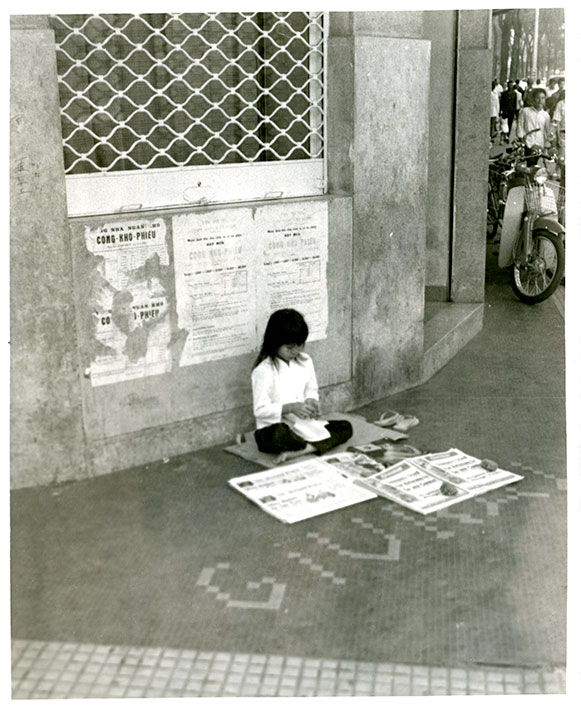
One more story: On one of my trips to the field, I was a bit late getting started for home and I had a problem finding a ride. Finally, there was a helicopter going to Saigon and I was able to hitch a ride. They didn’t know me, so when we got to where they were going they landed and let me out. I ended up in a part of town I did not know. I stood on the corner, thinking “What am I going to do?” Presently, a Vietnamese Army Officer came up to me and asked where I was going—in perfect English. I tried to explain the best I could, and he suddenly said, “Wait one minute.” He turned toward the traffic and began to try to flag down a car. Of course no one would stop. Finally, there was a small blue car with a young man and his wife coming by that did not stop either. The officer held his rifle up in the air then fired several rounds over the car, which then stopped quickly. He took me by the arm toward the car. When he got there he told the driver where I wanted to go and ordered him to take me there. He opened the back seat car door and pushed me into the seat and shut the door. The lady in the front seat was scared to death, as was the driver. I apologized the best I could, in English (of course), and away we went. It was a fairly long ride to the hotel but we eventually got there. Many thoughts were going through my head during this trip: Would I ever get to the hotel? Was this driver a Viet Cong? No one would ever find me. Oh, what would I do?
Well, I was safely dropped at the hotel and the little blue car sped away. I often think about this trip.
A final memory:
On July 20, 1969, I had been on a trip into the field to Tra Cu, to visit RivDiv 552 and had just returned from the river with a company of boats. As I walked ashore, I went to a tent where we usually got refreshments. There was a small group of sailors outside the tent with a prisoner they were talking to. I took small notice of this and went into the tent. The TV was on. As I looked at the screen, I realized I was watching Neil Armstrong and Buzz Aldrin who had just stepped from the lunar module onto the moon and were talking. “One giant leap for mankind…” What a scene to be watching from this small tent in a war zone in South East Asia.
This all happened over 48 years ago. Some things we never forget.
***
Wayne received a commendation from VADM Zumwalt upon his return from Vietnam.
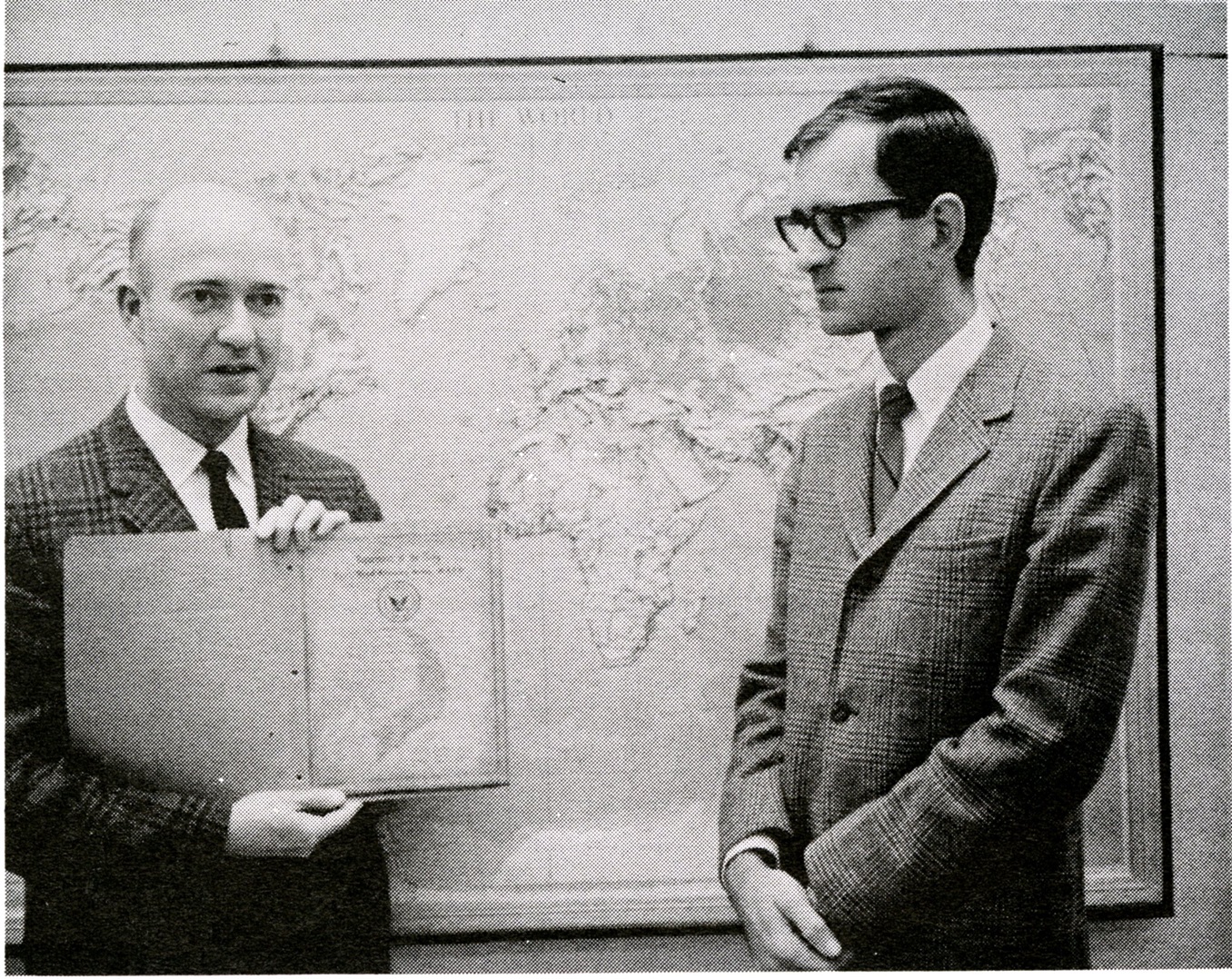
David R. Brown, who at the time was Acting Head of the FBM Geoballistics Division (KG) shows off Wayne’s award from VADM Zumwalt.
The commendation concluded with:
“Your extensive and creative analyses of the Sea Lords Campaign has contributed materially to Naval Operations in the Delta. These and other analyses were conducted with a high degree of professionalism exhibiting the finest qualities of initiative, judgment and devotion to duty.
“You have reflected lasting credit on yourself, this command and your parent command, the Naval Weapons Laboratory, Dahlgren, Virginia.”